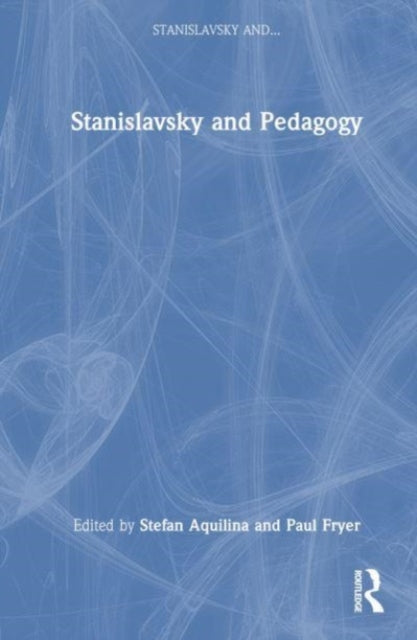Shulph Ink
Stanislavsky and Pedagogy
Stanislavsky and Pedagogy
YOU SAVE £6.48
- Condition: Brand new
- UK Delivery times: Usually arrives within 2 - 3 working days
- UK Shipping: Fee starts at £2.39. Subject to product weight & dimension
Bulk ordering. Want 15 or more copies? Get a personalised quote and bigger discounts. Learn more about bulk orders.
Couldn't load pickup availability
- More about Stanislavsky and Pedagogy
This book explores Stanislavsky's system and its legacy in contemporary actor training, offering insights for students, directors, teachers, and co-ordinators.
Format: Hardback
Length: 160 pages
Publication date: 07 July 2023
Publisher: Taylor & Francis Ltd
This comprehensive book delves into the intricate details of Stanislavsky's system and its enduring impact on contemporary actor training, considering the evolving teaching methods and ongoing debates surrounding pedagogical approaches. With a focus on students, directors, teachers, and coordinators who operate within actor training environments, this text stands as the sole resource that approaches Stanislavskian methods from this unique perspective, featuring contributions from multiple authors to provide a diverse range of insights.
Stanislavsky's system, which he developed over his career, is widely recognized as a groundbreaking approach to actor training. It emphasizes the importance of the actor's inner life, emotional connection to the character, and the use of imagination and intuition to bring the character to life on stage. Stanislavsky's techniques, such as the "method of physical action," "emotion memory," and "sense memory," continue to be influential in actor training today.
However, the application of Stanislavsky's system has been subject to debate and criticism over the years. Some argue that it is too rigid and prescriptive, limiting the actor's creativity and individuality. Others argue that it is outdated and irrelevant in the modern world, where actors are expected to perform in a wide range of styles and genres.
In response to these concerns, there has been a growing movement toward more flexible and inclusive pedagogical approaches in actor training. These approaches prioritize the development of the actor's physical and vocal skills, as well as their emotional and psychological well-being. They also emphasize the importance of collaboration and communication between the actor and the director, as well as the broader creative team.
One example of a flexible and inclusive pedagogical approach is the "Laban Movement," which was developed by Hungarian actor and choreographer George Laban. The Laban Movement emphasizes the use of movement and gesture to communicate emotions and ideas, and it emphasizes the importance of the actor's physical and emotional state in their performance. The movement also incorporates elements of other artistic disciplines, such as dance and theater, to create a holistic and integrated approach to actor training.
Another example of a flexible and inclusive pedagogical approach is the "Meisner Technique," developed by American actor and teacher Sanford Meisner. The Meisner Technique focuses on the development of the actor's "observational skills" and their ability to respond to the actions and emotions of their fellow actors. The technique emphasizes the importance of the actor's "inner life" and their ability to use their imagination and intuition to bring the character to life.
Despite the growing diversity of pedagogical approaches in actor training, there is still a strong appreciation for the legacy of Stanislavsky's system. Many actors and directors continue to use his techniques and principles to create powerful and meaningful performances. However, they also recognize the need to adapt and evolve these techniques to meet the changing demands of the industry and the evolving expectations of audiences.
In conclusion, this comprehensive book explores the various facets of Stanislavsky's system and its legacy in contemporary actor training, considering the evolving teaching methods and debates around pedagogical approaches. It provides a valuable resource for students, directors, teachers, and coordinators who work in actor training environments, offering a diverse range of perspectives and insights into the art of acting. Whether you are a seasoned actor or a newcomer to the field, this book will help you deepen your understanding of Stanislavsky's system and its impact on the world of theater and performance.
Weight: 480g
Dimension: 234 x 156 (mm)
ISBN-13: 9781032367538
This item can be found in:
UK and International shipping information
UK and International shipping information
UK Delivery and returns information:
- Delivery within 2 - 3 days when ordering in the UK.
- Shipping fee for UK customers from £2.39. Fully tracked shipping service available.
- Returns policy: Return within 30 days of receipt for full refund.
International deliveries:
Shulph Ink now ships to Australia, Belgium, Canada, France, Germany, Ireland, Italy, India, Luxembourg Saudi Arabia, Singapore, Spain, Netherlands, New Zealand, United Arab Emirates, United States of America.
- Delivery times: within 5 - 10 days for international orders.
- Shipping fee: charges vary for overseas orders. Only tracked services are available for most international orders. Some countries have untracked shipping options.
- Customs charges: If ordering to addresses outside the United Kingdom, you may or may not incur additional customs and duties fees during local delivery.


